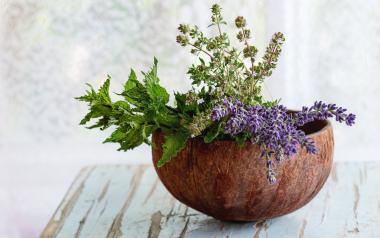You are likely familiar with the herbs you use in your kitchen daily, but did you know that herbs have been used as natural remedies for millennia? For many things from treating injuries to supporting postpartum conditions (some herbs should not be taken while pregnant or breastfeeding, so consult a health practitioner), herbs are a wonderful way to restore health, maintain function, and, of course, enhance flavour! They are quite easy to grow on your own as well. As a permaculturist, I look to natural patterns to make my garden more efficient and functional, and a favourite and ubiquitous one is the spiral. An herb spiral (see instructions below!) takes advantage of vertical space for growing — thus saving you a lot of precious garden terrain. It also creates multiple microclimates so that you can grow herbs that like hot dry conditions quite close to those that like less intense or wetter conditions.
If you have the spiral right outside your kitchen, it’s a one-stop shop at dinner time and you barely even have to bend over to harvest. The spiral can be shaped out of bricks, rocks, concrete rubble, wood, wine bottles, or any other salvaged material. If you want to get fancy, you can include a little irrigation pipe up the middle of it with a mini sprinkler head on top so that it is easier to water.
I prefer to include mainly perennials in the herb spirals I design for clients as they won’t have to worry about replanting each year, but there are indispensable annual herbs like basil that you’ll just have to do that extra work for if you want them in your spiral. Perennials will also hold the soil in place so it does not get washed away when watering.
Ten top healing herbs
Most herbs have some healing properties, but I’ll list a few of the most effective ones that you might want to keep around as part of your medicine cabinet here. All of these healing herbs are perennial, except for calendula.
Comfrey*
A poultice made from crushed leaves stimulates cell growth. It promotes the healing of bruises, wounds, ulcers, burns, sprains, sore breasts, etc. Comfrey also makes an excellent compost tea to spur on the growth of your other garden plants.
Sage
Taken internally, it has antibacterial and antiseptic properties and is also antihypertensive, anti-diabetic, and anti-inflammatory. Ingest with moderation while breastfeeding, as it can slow lactation.
Chamomile
Calming, and reduces anxiety to help you sleep. Can worsen asthma, however, and should also be avoided while pregnant.
Lemon balm*
Antiviral properties. A tea of fresh leaves made with hot but not boiling water helps insomnia and shingles. Concentrated ointment can speed recovery from cold sores.
Mint*
Mint tea is a gentle aid for digestion.
Lavender
Used internally for headaches, tension and to promote sleep. Whole sprigs or a satchel can be put under your pillow to calm and induce sleep.
Calendula
Anti-inflammatory, antimicrobial, astringent, antifungal and an immunostimulant. Use in ointments for disinfecting and speeding the healing process of skin. The bright petals are also a beautiful addition to salads and are a great pest repellant in the garden. Calendula is an annual.
Thyme
Used as a disinfectant. A tea of dried leaves relaxes the throat and reduces coughing.
Bee Balm and Wild Bergamot
Tea from the fresh or dried leaves is a mild sedative, relieves nausea, and helps with gas and bloating. Can be used externally as an antiseptic wash or poultice. These beautiful flowers also attract butterflies and beneficial insects to your garden.
*Be careful with the placement of these herbs as they tend to spread and need to be contained or they will take over your garden!
How to build an herb spiral
- Find a sunny location as close to your kitchen door as possible. This can be on a hard surface or on soil.
- Pile up a mound of good soil 3 ft high and 5 ft across. If you want to save on soil, you can put a small pile of rocks in the middle at the base.
- Lay rocks (or your chosen material) in a spiral pattern starting at the outside edge and working your way to the center as you go up the pile. Rocks should be between 3” to 1.5’ in size.
- Leave around 1 ft of soil between each loop of the spiral for planting.
- Plant your herbs according to the conditions they like. Herbs that love the heat and dryness —- such as sage and thyme — should be at the top, and herbs that like cooler, wetter conditions — such as chives and parsley — on the north side of the spiral at the bottom.
- Mulch with leaves, straw, or wood chips to hold soil in place until the plants are more established and to reduce watering and colonization of the bare soil by weeds.
- Water carefully and deeply so as not to wash away soil.
- Harvest and enjoy!
Remember to discuss all herbal remedies with your wellness practitioner before usage!
*Originally published February 27, 2016






